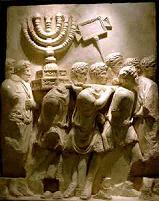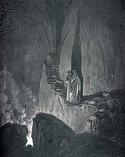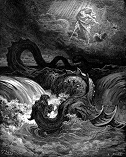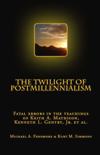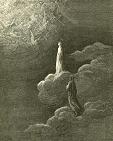Exposition of Revelation Chpt. 9-11
Chapter Nine – Romans, Zealots, & Idumeans
The imagery of the present chapter is adapted in part from the prophet Joel, who described successive invasions of locusts that devoured the land like fire. Joel appears to have used the imagery both literally to describe an actual drought and plague of locusts (Joel 1:1-10), and figuratively for the armies of the Assyrians and Babylonians (Joel 2:1-11; cf. Jer. 52:27). Moreover, it is clear that Joel’s prophecies had a plenior sensus (fuller meaning) that looked to the A.D. 70 destruction of Jerusalem. Peter cited Joel on the day of Pentecost, saying that the gifts of the Holy Ghost were among the signs that were to occur before the “great and notable day of the Lord” (Acts 2:20). Peter limited the period remaining to the day of the Lord when he said “save yourselves from this untoward generation” (v. 40). “This generation” was the timeframe set by the Lord for the vengeance that would overtake Jerusalem for the blood of the martyrs (Matt. 23:37). He then reiterated this timeframe in his Olivet Discourse, limiting the events described to “this generation” (Matt. 24:30, 34). Jesus repeated these warnings before the Sanhedrin and to the women of Jerusalem as he was led out to be crucified (Matt. 26:64; Lk. 23:27-31). Stephen made the same predictions and was stoned for it (Acts 6:14). John here portrays the same predictions clothed in poetic language adapted from Joel, signifying the imminent fulfillment of the prophecies.
Rev. 9:1, 11 – Roman Emperor, Angel of the Bottomless Pit
The last three trumpets are described as three “woes” (Rev. 8:13; 9:12; 11:14). The fifth trumpet introduces the first woe. John sees a star fall from heaven to earth; the star is given the key of the bottomless pit. He opens the pit and great billows of smoke that darken the air boil forth. From the smoke come locusts shaped like “scorpion-centaurs” with the bodies of horses but tails of scorpions. The locusts form a great army. But unlike locusts, which denude the land of vegetation, this army denudes the land of men. Yet not all men, but only those men what have not the seal of God upon their foreheads. They have as king over them the angel (star) of the bottomless pit.
The bottomless pit is Hades Tartarus, the interim abode of the wicked dead. Because the poisonous gases it emitted killed all birds that flew above its mouth, the Greeks and Romans called the entrance to Hades Avernus (“birdless”). It is represented by the poets as a crater whose mouth holds a lake that was believed to be the entrance to the underworld.[1] The connection with the present imagery is obvious. The Old Testament contains many passages describing the “pit” as the place to which the defeated armies of the uncircumcised descend (Isa. 14:15, 19; Ezek. 32:18-32). As the saints are citizens of heaven, the Gentiles were citizens of hell. The bottomless pit therefore was to the world spiritually, what the distant reaches of the Mediterranean Sea were geographically, and stands as a symbol of heathendom. Hence, the locust army here represents the forces of heathendom, the Roman army. The key to the bottomless pit represents the governmental authority and power of the empire. The king who holds the key and commands the legions is the Roman emperor, Nero, whose name is given in Greek “Apollyon” (destroyer), but in Hebrew is “Abaddon” (destruction), the same word used for Sheol and the pit (Job 26:6; Prov. 15:11; 27:20).
Taken together, the imagery is best understood as the Roman invasion of Judea, as seen from the fact that they are charged to kill only those who refused the gospel call when it went through Palestine, sealing the 144,000. The army is given power as scorpions to torment men for five months. John states that in those days men would “seek death, and shall not find it” (v. 5, 6). This may refer to the summer campaign following the fall of Galilee, or look ahead to the siege of Jerusalem, which lasted five months (Nisan 14-Elul 8). Unable to gain Jerusalem’s walls, the Romans shut the inhabitants up within the city to weaken their defenses, while famine devoured the inhabitants.
“So now all hope of escaping was cut off from the Jews, together with their liberty of going out of the city. Then did the famine widen its progress, and devoured the people by whole houses and families; the upper rooms were full of women and children that were dying by famine; and the lanes of the city were full of the dead bodies of the aged; the children also and the young men wandered about the market-places like shadows, all swelled with famine, and fell down dead Wheresoever their misery seized them. As for burying them, those that were sick themselves were not able to do it; and those that were hearty and well were deterred from doing it by the great multitude of those dead bodies, and by the uncertainty there was how soon they should die themselves; for many died as they were burying others, and many went to their coffins before that fatal hour was come!”
When the sixth angel sounds, a second invading force appears (v. 15). This may represent the Zealots and Idumeans. After the Romans subdued Galilee, the Zealots and robber bands fled to Jerusalem. However, when they tried to take over the city, they were set upon the high priests and elders of the Jews, and who shut up in the temple like a prison. The Zealots sent to the Idumeans to assist them. The Idumeans responded with an army 20,000 strong under four commanders, perhaps answering the four angels of v. 15. The Jews shut the gates of the city against them. That night, a great storm of preternatural proportions descended, with great winds, continual lightnings, thunderings, and earthquakes. The violence of the storm allowed the Zealots to escape their prison unnoticed and let the Idumeans into the city, who proceeded to make a general slaughter of the citizens, including the high priests, until twenty-thousand were slain:
But the rage of the Idumeans was not satiated by these slaughters; but they now betook themselves to the city, and plundered every house, and slew everyone they me; and for the multitude, they esteemed it needless to go on with killing them, but they sought for the high priests, and the generality went with the greatest zeal against them; and as soon as they caught them they slew , and then standing upon their dead bodies, in way of jest upbraided Ananus with his kindness to the people, and Jesus with his speech made to them from the wall. Nay, they proceeded to that degree of impiety, as to cast away their bodies without burial, although used to take so much care of the burial of men, that they took down those that were condemned and crucified, and buried them before the going down of the sun. I should not mistake if I said that the death of Ananus the beginning of the destruction of the city, and that from this very day may be dated the overthrow of her wall, and the ruin of her affairs, whereon they saw their high priest, and the procurer of their preservation slain the midst of the city...cast out naked, and see to be the food of dogs and wild beasts[2].
Alternatively, it may look ahead to the legions under Titus, which came from Egypt and the surrounding countries, converging on Jerusalem at the height of Passover celebration, shutting up within the city nearly 2 million Christ-denying Jews, most of whom perished in the siege. Titus had for his assistance in the siege four kings, Antiochus king of Commagene, Agrippa II king of Chalcis, Sohemus king of Emesa, and Malchus king of Arabia who may answer the four angels loosed in v. 15.[3]
Chapter Ten – No More Delay: the Drama Nears its Close
The second woe announced under the sixth trumpet began in Rev. 9:12, 13, but does not conclude until Rev. 11:14. The material inserted in chapter ten and the first fourteen verses of chapter eleven thus stands as something of an interlude or parenthesis. John sees a mighty angel, whose legs are pillars of fire, clothed with a cloud, whose face was is as the sun, and a rainbow upon his head. The angel stands with one foot upon the earth and the other upon the sea. His cry is as a lion when it roars, and the seven thunders answer him. The angel’s posture suggests dominion over earth; that his voice is like a lion roaring over his prey seems to confirm this. The Seven Thunders remind us of God when he answered Jesus in the gospel of John (Jn. 12:29), suggesting that the angel here is a depiction of Christ. Like Paul who was prohibited to write the things he saw when borne away to paradise (II Cor. 12:1-4), John is prohibited to write the things uttered by the Seven Thunders – which may have announced the time of Christ’s return. Jesus began his ministry stating the “time is fulfilled and the kingdom of God is at hand” (Mk. 1:15). Paul later wrote “the time is short” (I Cor. 7:29). James wrote “the coming of the Lord draweth nigh” and was “at the door” (Jm. 5:8, 9). The writer of Hebrews said it was a “very, very little while, and he that shall come will come, and will not tarry” (Heb. 10:37). Now, the angel declares “there shall be no more time” (no more delay), but that in the days when the seventh angel sounds all would be concluded. The seventh and “last trump” therefore is extremely important; it brings in its train the kingdom and resurrection of the dead, which in plainest terms are tied to the fall of Jerusalem.
John is told to eat a little book in the angel’s hands, which turns his belly bitter. The angel tells John that he must “prophesy again before many peoples, and nations, and tongues, and kings” (Rev. 10:11). This signifies that John would survive the events portrayed in Revelation and would preach again amongst much opposition (hence the bitterness). Jesus said some of the disciples would live until his return (Matt. 16:27, 28; cf. I Thess. 4:15), and specifically named John. “If I will that he tarry till I come, what is that to thee?” (Jn. 21:21, 22). The present passage confirms Jesus’ earlier prediction, and records John’s commission to preach the gospel in the years following the eschaton.
Chapter Eleven – Jerusalem’s Fall and the Coming of the Kingdom and Resurrection
This chapter concludes the second vision. The first half describes “two witnesses,” the second half, events under the seventh trumpet.
Rev. 11:1-14 – The Two Witnesses and the Persecution under Nero
This chapter describes in symbolic terms a similar situation to that in chapter seven where four angels hold back the winds of heaven until the remnant 144,000 Jews are sealed, followed by the outbreak of persecution and war. Here, measuring the temple and those that worship therein takes the place of sealing the 144,000, describing in different terms substantially the same thing. Those “measured” are the church. The outer court, or court of the Gentiles, which was not measured, is apostate Judaism; it nominally worships the Lord, but is to be “cast out” from the covenant relation with God. Jesus thus states, “And I say unto you, That many shall come from the east and west, and shall sit down with Abraham, and Isaac, and Jacob, in the kingdom of heaven. But the children of the kingdom shall be cast out into outer darkness: there shall be weeping and gnashing of teeth” (Matt. 8:11, 12; cf. Gal. 4:24). John indicates that the holy city will be trodden under foot forty-two months, signifying the Jews’ 3 ½ year war with Rome. This is confirmed by the Olivet Discourse, which mirrors the language here. “And they shall fall by the edge of the sword, and shall be led away captive into all nations: and Jerusalem shall be trodden down of the Gentiles, until the times of the Gentiles be fulfilled” (Lk. 21:24).
The two witnesses, which are called the two candlesticks and olive trees that stand before the God of all the earth, are associated with the temple that John was told to measure, and provide its spiritual light and leadership. In the book of Zechariah, similar imagery pointed in the first instance to Joshua the high priest and Zerubbabel the governor (Zech. 4), although in its messianic context the imagery looked ahead to Christ who descended from the families of Joshua and Zerubbabel (Mary’s kinswoman, Elizabeth, was of the daughters of Aaron, Lk. 1:5). Here, the two witnesses probably point to Peter and Paul, who are widely viewed as the two most prominent personalities in the early church. Both Peter and Paul also spoke of their impending martyrdom and thus conform to the overall imagery here (II Tim. 4:6-8; II Pet. 1:14; cf. Jn. 21:18, 19).
The two witnesses are given power to preach for 1,260 days, during which they are protected by the ability to call down plagues upon their adversaries. After they have finished their testimony, the beast that ascends from the bottomless pit will make war upon them and kill them, leaving their bodies lying unburied for 3 ½ days, in “the street of the great city, which is spiritually called Sodom and Egypt, where also our Lord was crucified” (vv 7, 8). This seems to point to the 3 ½ years period beginning when Paul was sent to Rome for trial until the persecution under Nero (A.D. 60-64). The point seems to be that the gospel would continue to have free course for the time signified a fact to which Luke and Paul both testify (Acts 28:30, 31; Phil. 1:12-18) but that following this the great eschatological crisis of the end time would break out. The purpose in singling out the martyrdom of Peter and Paul apparently is to mark the beginning of the crisis. The 3 ½ days the bodies of the two witnesses (but by extension, the church in general) lay unburied signifies the 3 ½ year persecution of A.D. 64-68. The “great city” elsewhere called Babylon the Harlot, but here Sodom and Egypt is Jerusalem. By extension, she represents all Jewry, for she “sits upon many waters” (Rev. 17:1, 15), signifying apostate Judaism’s presence throughout the Roman Empire and its hostility to the gospel. The martyrs do not literally lie in the Jerusalem. Rather, she bears the moral blame and responsibility for the persecution; the martyrs’ blood is laid at her feet.
“Wherefore, behold, I send unto you prophets, and wise men, and scribes: and some of them ye shall kill and crucify; and some of them shall ye scourge in your synagogues, and persecute them from city to city: That upon you may come all the righteous blood shed upon the earth, from the blood of righteous Abel unto the blood of Zacharias son of Barachias, whom ye slew between the temple and the altar. Verily I say unto you, All these things shall come upon this generation. O Jerusalem, Jerusalem, thou that killest the prophets, and stonest them which are sent unto thee, how often would I have gathered thy children together, even as a hen gathereth her chickens under her wings, and ye would not! Behold, your house is left unto you desolate.” Matt. 23:34-38
In the midst of glorying over the martyrs and sending one another gifts, the martyrs suddenly revive and ascend to heaven in their enemies’ sight. The same hour there is a great earthquake and a tenth part of the city falls and 7,000 men perish in the quake. With this, the angel announces that the second woe, begun in Rev. 9:13, is now past. Just as lying in the street of Jerusalem is not literal, the martyrs’ ascension is not literal, but describes the reversal of circumstances that suddenly confronted the Jews. The church, which was undergoing persecution, was suddenly released from her trials and gained the upper hand over the Jews. The persecution ended with the death of Nero (June, A.D. 68) in the midst of the war with Rome. Rome lost interest in Christianity, but pursued with great purpose and intensity the annihilation of Jerusalem. It cannot be known for certain what event in the war the quake here depicts. However, the division and infighting that erupted among the competing factions of the Jews answers well the imagery of a divided city and fits the time frame suggested here (cf. Rev. 16:18, 19).
Rev. 11:15-19 – The Kingdom and Resurrection Come
Omitting further detail of the destruction of Christ’s enemies, the seventh angel sounds, and voices in heaven proclaim “the kingdoms of the world are become the kingdoms of our Lord and of his Christ, and he shall reign forever and ever” (v. 15). With this announcement, the kingdom has now come in power (Matt. 16:27, 28; Mk. 9:1) and all enemies have been placed beneath Christ’s feet (Ps. 110:1; Heb. 2:8). This does not mean that all temporal opposition has forever ceased, or that other enemies will not rise at later times. It does means that Christ has “shown who is the only Potentate, King of kings and Lord of lords” (I Tim. 6:15), and that he is firmly established in his kingdom, not merely as a matter of law, but as an indisputable matter of fact. The kingdom is not the church. Rather, the kingdom (dominion) is the world, which Christ rules with an iron rod. For the church, the kingdom means restored spiritual liberty from the dominion of sin and death, and temporal dominion over their enemies through the reign of Christ. The dominion that belonged to the dragon and beast is become Christ’s and his saints:
“And the kingdom and dominion, and the greatness of the kingdom under the whole heaven, shall be given to the saints people of the saints of the most High, whose kingdom is an everlasting kingdom, and all dominions shall serve and obey him” (Dan. 7:27).
Resurrection tied to Coming of Kingdom (vv. 17, 18)
The coming of the kingdom in power was inexorably tied to the resurrection. If the resurrection has not come, neither has the kingdom. Thus, the twenty-four elders join the kingdom and resurrection, saying,
“We give thee thanks, O Lord God Almighty, which art, and wast, and art to come; because thou hast taken to thee thy great power, and hast reigned. And the nations were angry, and thy wrath is come, and the time of the dead, that they should be judged, and that thou shouldest give reward unto the saints, and them that fear thy name, small and great; and shouldest destroy them that destroy the earth.”
Matthew is to the same effect, joining the kingdom and judgment:
“For the Son of man shall come in the glory of his Father with his angels; and then he shall reward every man according to his works. Verily I say unto you, There be some standing here, which shall not taste of death, till they see the Son of man coming in his kingdom” (Matt. 16:27, 28).
Paul joins them as well:
“I charge thee therefore before God, and the Lord Jesus Christ, who shall judge the quick and the dead at his appearing and his kingdom” (II Tim. 4:1).
Resurrection tied to Fall of Jerusalem (vv. 2, 18)
But if the kingdom and resurrection are tied together by Matthew and Paul, Daniel and John expressly tie the resurrection to the fall of Jerusalem.
|
Daniel 12: 2, 7 And many of them that sleep in the dust of the earth shall awake, some to everlasting life, and some to shame and everlasting contempt...when he shall have accomplished to scatter the power of the holy people, all these things shall be finished. |
Rev. 11:2, 18 And the holy city shall they tread under foot forty and two months... And the nations were angry, and thy wrath is come, and the time of the dead, that they should be judged.
|
|
Here is incontrovertible evidence that the eschaton was fulfilled in the events culminating in the destruction of Jerusalem in A.D. 70. There is simply no avoiding the force of the argument. The resurrection from Hades marked the destruction of the last enemy. Since the resurrection is expressly tied to the fall of Jerusalem, all is fulfilled. The general resurrection of the accumulated souls in Hades is past. Naturally, judgment continues (Heb. 9:27) as does resurrection. Those on this side of the eschaton are judged at death and go on to our respective rewards at that time. Only Hadean death has been destroyed.
[1] A deep, deep cave there was, its mouth enormously gaping,
Shingly, protected by the dark lake and the forest gloom:
Above it, no winged creatures could ever wing their way
With impunity, so lethal was the miasma which
Went fuming up from its black throat to the vault of heaven:
Wherefore the Greeks called it Avernus, the Birdless Place.
Virgil, Aeneid, lines 236-242; cf. lines 568-571.
[2] Ibid, IV, v, 2; Whiston ed.
To receive Kurt Simmons’ e-mail newsletter, The Sword & The Plow, click the Subscribe link:
All rights reserved.
